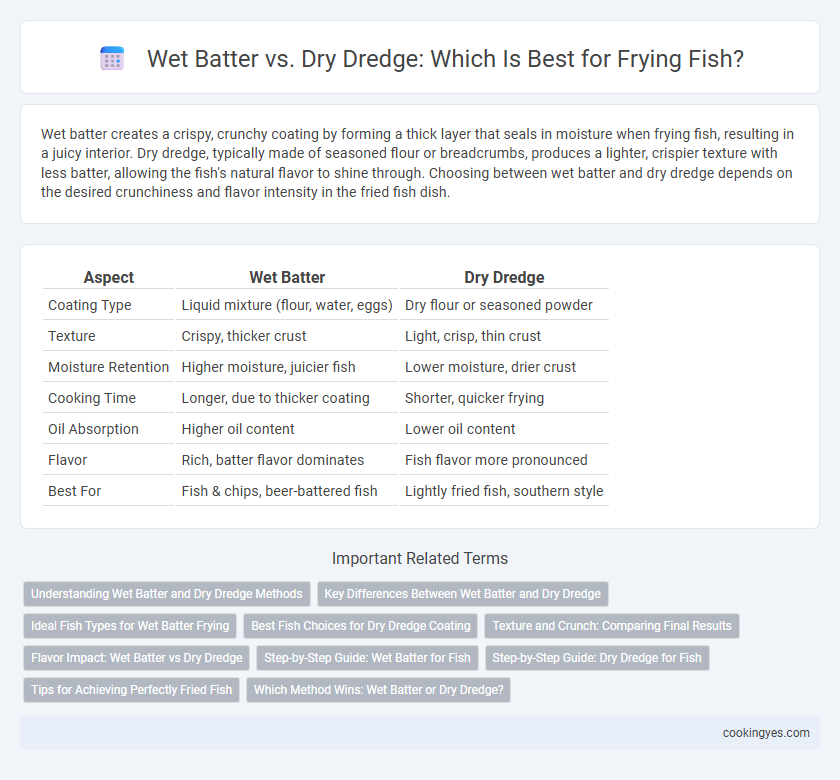Wet batter creates a crispy, crunchy coating by forming a thick layer that seals in moisture when frying fish, resulting in a juicy interior. Dry dredge, typically made of seasoned flour or breadcrumbs, produces a lighter, crispier texture with less batter, allowing the fish's natural flavor to shine through. Choosing between wet batter and dry dredge depends on the desired crunchiness and flavor intensity in the fried fish dish.
Table of Comparison
| Aspect | Wet Batter | Dry Dredge |
|---|---|---|
| Coating Type | Liquid mixture (flour, water, eggs) | Dry flour or seasoned powder |
| Texture | Crispy, thicker crust | Light, crisp, thin crust |
| Moisture Retention | Higher moisture, juicier fish | Lower moisture, drier crust |
| Cooking Time | Longer, due to thicker coating | Shorter, quicker frying |
| Oil Absorption | Higher oil content | Lower oil content |
| Flavor | Rich, batter flavor dominates | Fish flavor more pronounced |
| Best For | Fish & chips, beer-battered fish | Lightly fried fish, southern style |
Understanding Wet Batter and Dry Dredge Methods
Wet batter coating for fish involves dipping the fillets into a liquid mixture of flour, water or beer, and seasonings, creating a thick, crispy crust that seals in moisture during frying. Dry dredge method uses a simple dry mix of flour, cornmeal, or breadcrumbs with spices, providing a lighter, crunchier texture that allows more of the fish's natural flavor to shine through. Recognizing the difference between these methods helps optimize frying techniques based on desired crispiness, moisture retention, and flavor profile in fish dishes.
Key Differences Between Wet Batter and Dry Dredge
Wet batter for frying fish creates a crispy, golden coating by trapping moisture and allowing even heat distribution, resulting in a light texture. Dry dredge uses seasoned flour or breadcrumbs, providing a thinner, crunchier crust that absorbs less oil and enhances natural flavors. The choice depends on desired texture and flavor intensity, with wet batter typically producing thicker, more indulgent coatings, while dry dredge delivers a leaner, crisp finish.
Ideal Fish Types for Wet Batter Frying
Wet batter is ideal for delicate fish varieties such as cod, haddock, and sole, providing a crispy, thick coating that seals in moisture and prevents delicate flesh from drying out. This method enhances white flaky fish by creating a light and airy texture that complements their mild flavor. Wet batter frying is less suited for oily fish, which benefit more from dry dredge methods to maintain their natural oils and robust taste.
Best Fish Choices for Dry Dredge Coating
Firm and flaky fish such as cod, haddock, catfish, and snapper are ideal for dry dredge coatings due to their ability to hold seasoning and develop a crisp texture. Dry dredging with seasoned flour or cornmeal enhances the natural flavor and provides a crunchy exterior without the heaviness of wet batter. These fish types withstand high heat frying well, ensuring a perfectly cooked interior and a golden, crispy crust.
Texture and Crunch: Comparing Final Results
Wet batter creates a crispy, bubbly crust with a moist, tender interior, providing a light texture that clings well to fish. In contrast, dry dredge results in a thinner, crunchier coating that emphasizes a more robust, textured bite. Fish fried with wet batter tends to retain juiciness, while dry dredging offers a drier, firmer crust with enhanced crispness.
Flavor Impact: Wet Batter vs Dry Dredge
Wet batter creates a crispy, flavorful coating that locks in moisture and enhances the fish's natural taste with a rich, savory texture. Dry dredge offers a lighter, crunchier exterior that highlights the fish's freshness without overpowering its subtle flavors. Choosing between wet batter and dry dredge significantly affects the flavor profile and mouthfeel of fried fish dishes.
Step-by-Step Guide: Wet Batter for Fish
For a perfect wet batter for fish, start by mixing cold water or beer with flour, baking powder, and seasoning to create a smooth, lump-free batter. Dip the fish fillets into the wet batter, ensuring full coating before frying in hot oil at 350degF to 375degF for a crispy, golden crust. This method seals in moisture, resulting in tender, flaky fish with a light, crunchy exterior that outperforms dry dredging in texture and flavor retention.
Step-by-Step Guide: Dry Dredge for Fish
Coat fish fillets evenly with seasoned flour in the dry dredge step to create a crispy outer layer when fried. Ensure excess flour is lightly shaken off before placing the fish in hot oil, maintaining optimal crunch without a doughy texture. This method enhances flavor absorption while providing a golden-brown finish superior to wet batter in certain frying applications.
Tips for Achieving Perfectly Fried Fish
For perfectly fried fish, using wet batter creates a crisp, golden crust that locks in moisture, while dry dredge offers a lighter, crunchier texture that lets the fish's natural flavor shine. Ensure the oil temperature stays between 350-375degF to prevent sogginess and promote even cooking. Patting fish dry before coating and allowing the batter or dredge to adhere properly enhances the final crispiness and flavor balance.
Which Method Wins: Wet Batter or Dry Dredge?
Wet batter creates a crisp, golden coating that locks in moisture, resulting in tender, juicy fish ideal for tempura or classic British fish and chips. Dry dredge, typically a seasoned flour or cornmeal mix, forms a lighter, crunchier crust that highlights the fish's natural flavor without overpowering it. Choosing between wet batter and dry dredge depends on desired texture and taste--wet batter delivers a thicker, crisp shell, whereas dry dredge offers a subtle, crisp finish preserving fish's delicate flavor.
Wet batter vs Dry dredge for frying Infographic

 cookingyes.com
cookingyes.com